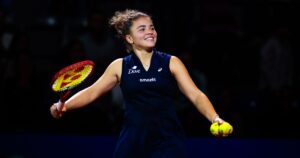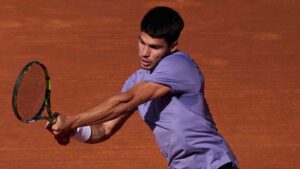
If a long-tested approach doesn’t seem to work, is it maintained or twisted?
That might have been Daniil Medvedev’s dilemma earlier this year, after suffering back-to-back losses to Carlos Alcaraz at Indian Wells and Wimbledon, respectively. In both matches, Medvedev struggled to counter Alcaraz’s excellent net play and use of dropshots, leading to suggestions that he may have to modify his signature deep return position to beat the Spaniard.
However, Medvedev is not one to question his own game, which has helped him win 20 tour titles and made him No. 1 in the ATP Pepperstone Rankings. He ignored any outside calls to position himself further forward to counter Alcaraz’s serve-and-volley attacks, and made a big comeback in the US Open semi-finals in September, when he defeated the Spaniard in four sets in New York.
“It was a great feeling, because before the match, especially against someone like Carlos, everyone on the internet was saying: ‘He has no chance if he doesn’t change his position,'” Medvedev told ATPTour.com. “You always have a chance. It’s just that against some types of players, maybe you’re going to be a little more vulnerable.”
Medvedev is 2-0 at this week’s Nitto ATP Finals after defeating Andrey Rublev and Alexander Zverev in Turin. On Friday he faces Alcaraz in his final Red Group match, the fifth Lexus ATP Head2Head matchup between the two. The World No. 3 hopes the result echoes his most recent meeting in New York, unlike their first two meetings of 2023.
Medvedev won only five games against Alcaraz in straight sets in the Indian Wells final in March, and nine games in three sets in the Wimbledon semi-final. While those results were disappointing, they were also a learning experience for Medvedev, who thought the spacious environment of Arthur Ashe Stadium could also help him in his preparation for the US Open clash.
“Before the match, I thought, ‘Okay, I see what he’s doing,'” Medvedev said. “I think maybe on this court at the US Open, maybe I’ll be good at returning from distance and I’ll be able to put him in trouble.”
“If I had seen that it wasn’t like that during the match, maybe I would have had to change it, but at Wimbledon I tried to change my position on the return, and it didn’t work at all. Especially on grass, it’s difficult to change things during the match. At the US Open I immediately felt that I could do something from this position. I can put him in trouble.'”
You May Also Be Interested: Medvedev Will Be Inspired By Djokovic To Face Alcaraz In Turin
Although he hasn’t made any significant changes to his return routine, that doesn’t mean Medvedev isn’t open to new ideas. As his coach, Gilles Cervara, revealed to ATPTour.com at the US Open, the pair studied a return position closer to the baseline when they began working together, although that ultimately proved impossible.
“There were certainly some moments when we tried to work on different things,” Medvedev recalls. “Sometimes I can be against it. I don’t remember exactly, but what usually happens is that at first I say: ‘Yes, it doesn’t matter. Why are we doing this?’ But then I try to do it right, so it’s a good job anyway. “Then the question is whether I do it in the game or not.”
Additionally, Medvedev does make changes to his return position that depend on the opponent, even if they are not obvious to the untrained eye. “I think people can see that there are some games where I go a little closer to the baseline, depending on the conditions,” he said. “There are some conditions where you’re going to break a guy maybe only once or twice in a three-set match.”
“I don’t care if I return close to the baseline and I always win one or two points because of it, but then I miss the other three returns and he always wins the match at 40/30. I’d rather lose maybe three games on the baseline I’d rather lose maybe three games at 40/0, where he’s going to serve and volley or something. But then there’ll be a game where he’ll get a little tight, and I’ll get one or two returns and break.”
“I’m always thinking, ‘How do I do it?’ Sometimes after the game I might think, ‘I should have done it differently,’ when I lose. You never know if it’s going to work, but sometimes I change. Sometimes [mis cambios] “They’re bigger, so people might notice, sometimes they don’t.”
Of course, whether or not to adjust a game plan for a specific opponent is not a dilemma unique to Medvedev. In fact, his return position makes the world number 3 himself an especially difficult proposition to prepare for, something he believes helped him become champion in Miami for the first time this year.
“I remember in Indian Wells, Alcaraz beat me quite easily, with a lot of drop shots,” Medvedev recalls. “Then in Miami the next week, all my opponents were trying to hit a lot of drop shots, but they weren’t doing it the same way. So I just ran and hit winners.”
Source: https://www.atptour.com/es/news/medvedev-turin-2023-returning-feature


